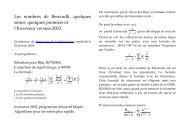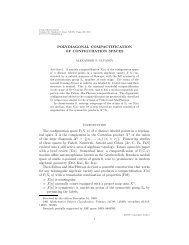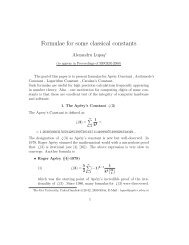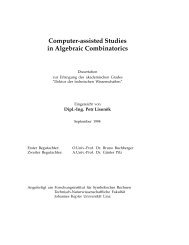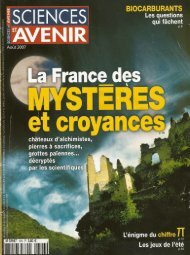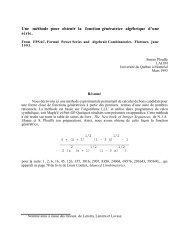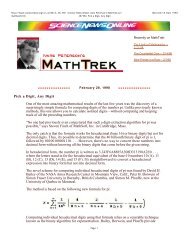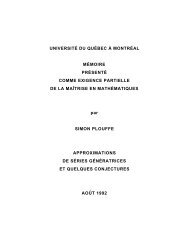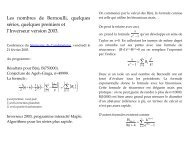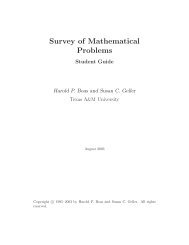The Miraculous Bailey-Borwein-Plouffe Pi Algorithm - Simon Plouffe
The Miraculous Bailey-Borwein-Plouffe Pi Algorithm - Simon Plouffe
The Miraculous Bailey-Borwein-Plouffe Pi Algorithm - Simon Plouffe
- No tags were found...
Create successful ePaper yourself
Turn your PDF publications into a flip-book with our unique Google optimized e-Paper software.
http://www.mathsoft.com/asolve/plouffe/plouffe.ht <strong>The</strong> <strong>Miraculous</strong> <strong>Bailey</strong>-<strong>Borwein</strong>-<strong>Plouffe</strong> <strong>Pi</strong> <strong>Algorithm</strong> Mardi 23 septembre 1997mlOverview: 10/1/95<strong>The</strong> <strong>Miraculous</strong> <strong>Bailey</strong>-<strong>Borwein</strong>-<strong>Plouffe</strong> <strong>Pi</strong> <strong>Algorithm</strong>Steven Finch, Research and Development Team, MathSoft, Inc.David <strong>Bailey</strong>, Peter <strong>Borwein</strong> and <strong>Simon</strong> <strong>Plouffe</strong> have recently computed the ten billionth digit in thehexadecimal expansion of pi. <strong>The</strong>y utilized an astonishing formula:which enables one to calculate the dth digit of pi without being forced to calculate all the preceding d-1 digits.No one had previously even conjectured that such a digit-extraction algorithm for pi was possible. Click hereto see the original CECM announcement and here to see a description for a non-technical audience. <strong>Bailey</strong>,<strong>Borwein</strong> and <strong>Plouffe</strong> discovered their formula using the PSLQ lattice reduction algorithm.We present here a very small verification of the digit-extraction result. Mathcad PLUS 6.0 was useful to us forthe purpose of a hasty check up to 1000 digits. A check of more digits is ongoing. We wished to post ourwork as rapidly as possible, believing that this incomplete work would be of interest to others.<strong>The</strong> Mathcad PLUS 6.0 file plffe1.mcd contains a dynamic, working version of our verification. If you have6.0 and don't know how to view web-based Mathcad files, then you should read these instructions.<strong>The</strong> following screenshot exhibits our verification algorithm (which, incidentally, we recognize is far lessefficient than <strong>Bailey</strong>, <strong>Borwein</strong> and <strong>Plouffe</strong>'s original algorithm).Page: 1
http://www.mathsoft.com/asolve/plouffe/plouffe.ht <strong>The</strong> <strong>Miraculous</strong> <strong>Bailey</strong>-<strong>Borwein</strong>-<strong>Plouffe</strong> <strong>Pi</strong> <strong>Algorithm</strong> Mardi 23 septembre 1997mlPage: 2
http://www.mathsoft.com/asolve/plouffe/plouffe.ht <strong>The</strong> <strong>Miraculous</strong> <strong>Bailey</strong>-<strong>Borwein</strong>-<strong>Plouffe</strong> <strong>Pi</strong> <strong>Algorithm</strong> Mardi 23 septembre 1997mlIt is trivial to convert a hexadecimal expansion to a binary expansion. On the other hand, the followingquestion evidently remains unanswered. Do there exist polynomials a(n) and b(n) possessing integercoefficients such thatPage: 3
http://www.mathsoft.com/asolve/plouffe/plouffe.ht <strong>The</strong> <strong>Miraculous</strong> <strong>Bailey</strong>-<strong>Borwein</strong>-<strong>Plouffe</strong> <strong>Pi</strong> <strong>Algorithm</strong> Mardi 23 septembre 1997ml<strong>The</strong> just-released, historic <strong>Bailey</strong>-<strong>Borwein</strong>-<strong>Plouffe</strong> paper, CECM preprint P123: On the rapid computation ofvarious polylogarithmic constants starts where we have left off. Reading it, one gains the impression of anemerging and deep theory of transcendental number computation. <strong>The</strong> untapped consequences of thedigit-extraction formula and others like it would appear to be rich and profound.Postscript: 1/15/96Victor Adamchik and Stan Wagon have recently published a fascinating HTML paper <strong>Pi</strong>: A 2000-Year SearchChanges Direction. This paper presents many new formulas, including the following:for any real or complex value r. Observe that this specializes to the original <strong>Bailey</strong>-<strong>Borwein</strong>-<strong>Plouffe</strong> formulawhen we set r = 0.We refer the interested reader to the essay Archimedes' constant for a detailed overview of pi facts andformulas and to CECM preprint P130: <strong>The</strong> Quest for <strong>Pi</strong>. <strong>Plouffe</strong> has also compiled a Table of current recordsfor the computation of constants which gives the latest information on calculations such as these.Postscript: 10/7/96Fabrice Bellard has completed a computation of the 100 billionth hexadecimal digit of pi. Here is his sci.mathposting, which interestingly appeared one year, almost to the day, after <strong>Bailey</strong>, <strong>Borwein</strong> and <strong>Plouffe</strong>'sannouncement. Might the one trillionth hexadecimal digit of pi be known next year?Postscript: 1/12/97<strong>Simon</strong> <strong>Plouffe</strong> has discovered a new algorithm to compute the nth digit of pi and certain other mathematicalconstants in any base with very little memory. <strong>The</strong> price of such generality is speed: it is not as fast as the<strong>Bailey</strong>-<strong>Borwein</strong>-<strong>Plouffe</strong> algorithm (but is comparable to other classical methods for computing pi). Here is adescription of his work, along with Bellard's improvement.Postscript: 2/28/97Progress continues! Fabrice Bellard has discovered another miraculous formula which he estimates is 43%faster than the <strong>Bailey</strong>-<strong>Borwein</strong>-<strong>Plouffe</strong> formula. A very simple proof is found here. Another CECM resourceis also now available: <strong>The</strong> <strong>Pi</strong> Pages.Postscript: 9/22/97Fabrice Bellard has employed the <strong>Bailey</strong>-<strong>Borwein</strong>-<strong>Plouffe</strong> formula to compute the trillionth (10 12th ) binarydigit of pi. Here is his e-message.Page: 4
http://www.mathsoft.com/asolve/plouffe/plouffe.ht <strong>The</strong> <strong>Miraculous</strong> <strong>Bailey</strong>-<strong>Borwein</strong>-<strong>Plouffe</strong> <strong>Pi</strong> <strong>Algorithm</strong> Mardi 23 septembre 1997mlThis page was modified September 22, 1997Copyright © 1997 MathSoft, Inc. All rights reserved.Page: 5



